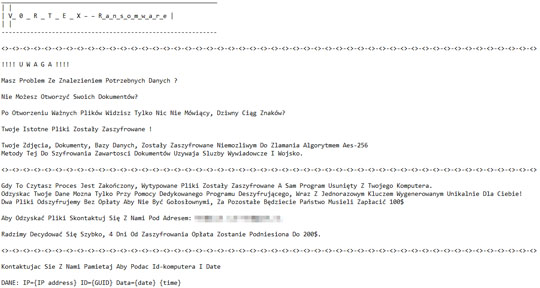RANSOM_VORTEX.Q
HEUR:Trojan-Ransom.MSIL.Generic (KASPERSKY); Trojan.Gen.2 (NORTON); Ransom:Win32/Genasom (MICROSOFT)
Windows


Threat Type: Ransomware
Destructiveness: No
Encrypted: Yes
In the wild: Yes
OVERVIEW
This Ransomware arrives on a system as a file dropped by other malware or as a file downloaded unknowingly by users when visiting malicious sites.
It connects to certain websites to send and receive information.
It encrypts files with specific file extensions. It drops files as ransom note.
TECHNICAL DETAILS
Arrival Details
This Ransomware arrives on a system as a file dropped by other malware or as a file downloaded unknowingly by users when visiting malicious sites.
Installation
This Ransomware drops the following files:
- %All Users Profile%\Keyboard\{date executed}_{time executed}.log - contains established IP address
(Note: %All Users Profile% is the All Users folder, where it usually is C:\Documents and Settings\All Users on Windows 2000, Windows Server 2003, and Windows XP (32- and 64-bit); C:\ProgramData on Windows Vista (32- and 64-bit), Windows 7 (32- and 64-bit), Windows 8 (32- and 64-bit), Windows 8.1 (32- and 64-bit), Windows Server 2008, and Windows Server 2012.)
Other System Modifications
This Ransomware adds the following registry entries:
HKEY_CURRENT_USER\Software\AESxWin
ComputerId = {GUID}
Other Details
This Ransomware connects to the following website to send and receive information:
- http://{BLOCKED}update.{BLOCKED}ass/
- http://{BLOCKED}update.{BLOCKED}ogin/post.php?IP={IP address}&ID={GUID}&Data={Date Executed}%20{Time Executed}&Haslo={Encrypted Password API}
It does the following:
- It executes the following command:
- vssadmin.exe delete shadows /all /Quiet
Ransomware Routine
This Ransomware encrypts files with the following extensions:
- .mpg
- .vob
- .mpeg
- .asf
- .avi
- .mov
- .mkv
- .flv
- .wma
- .mid
- .djvu
- .svg
- .psd
- .nef
- .tiff
- .tif
- .cgm
- .raw
- .gif
- .png
- .bmp
- .jpg
- .jpeg
- .vcd
- .iso
- .backup
- .zip
- .rar
- .tgz
- .tar
- .bak
- .tbk
- .PAQ
- .ARC
- .aes
- .gpg
- .vmx
- .vmdk
- .vdi
- .sldm
- .sldx
- .sti
- .sxi
- .hwp
- .snt
- .onetoc2
- .dwg
- .wks
- .rtf
- .csv
- .txt
- .vsdx
- .vsd
- .edb
- .odp
- .otp
- .sxd
- .std
- .uop
- .odg
- .otg
- .sxm
- .mml
- .lay
- .lay6
- .asc
- .sqlite3
- .sqlitedb
- .sql
- .accdb
- .mdb
- .dbf
- .odb
- .frm
- .myd
- .myi
- .ibd
- .mdf
- .msg
- .ost
- .pst
- .potm
- .potx
- .eml
- .der
- .pfx
- .key
- .crt
- .csr
- .pem
- .odt
- .ott
- .sxw
- .stw
- .uot
- .max
- .ods
- .ots
- .sxc
- .stc
- .dif
- .slk
- .asp
- .java
- .ppam
- .ppsx
- .ppsm
- .pps
- .pot
- .pptm
- .pptx
- .ppt
- .xltm
- .xltx
- .xlc
- .xlt
- .xlw
- .xlsb
- .xlsm
- .xlsx
- .xls
- .dotx
- .dotm
- .dot
- .docm
- .docb
- .docx
- .doc
- .xlm
- .jar
- .ldf
- .sln
- .suo
- .cpp
- .pas
- .asm
- .cmd
- .bat
- .vbs
- .dip
- .dch
- .sch
- .brd
- .jsp
- .php
- .class
- .wav
- .swf
- .fla
- .wmv
It avoids encrypting files with the following strings in their file path:
- System
It appends the following extension to the file name of the encrypted files:
- .aes
It drops the following file(s) as ransom note:
- %Desktop%\ODZSZYFRUJ-DANE.txt

SOLUTION
Step 1
Before doing any scans, Windows XP, Windows Vista, and Windows 7 users must disable System Restore to allow full scanning of their computers.
Step 2
Note that not all files, folders, and registry keys and entries are installed on your computer during this malware's/spyware's/grayware's execution. This may be due to incomplete installation or other operating system conditions. If you do not find the same files/folders/registry information, please proceed to the next step.
Step 3
Restart in Safe Mode
Step 4
Delete this registry value
Important: Editing the Windows Registry incorrectly can lead to irreversible system malfunction. Please do this step only if you know how or you can ask assistance from your system administrator. Else, check this Microsoft article first before modifying your computer's registry.
- In HKEY_CURRENT_USER\Software\Microsoft\Windows\CurrentVersion\Run
- IGFXTRAY = {Malware Path}\{Malware Name}.exe
- IGFXTRAY = {Malware Path}\{Malware Name}.exe
- In HKEY_CURRENT_USER\Software\AESxWin
- ComputerId = {GUID}
- ComputerId = {GUID}
Step 5
Search and delete this file
- %Desktop%\ODZSZYFRUJ-DANE.txt
- %All Users Profile%\Keyboard\{date executed}_{time executed}.log
Step 6
Restart in normal mode and scan your computer with your Trend Micro product for files detected as RANSOM_VORTEX.Q. If the detected files have already been cleaned, deleted, or quarantined by your Trend Micro product, no further step is required. You may opt to simply delete the quarantined files. Please check this Knowledge Base page for more information.
Step 7
Restore encrypted files from backup.
Did this description help? Tell us how we did.

